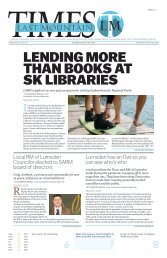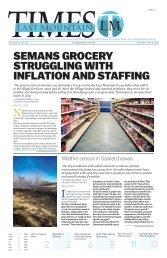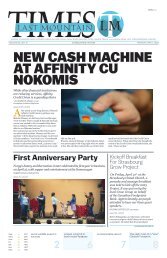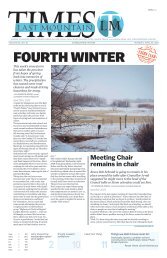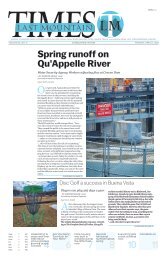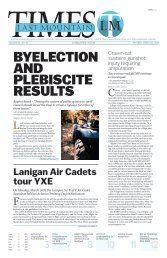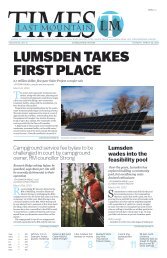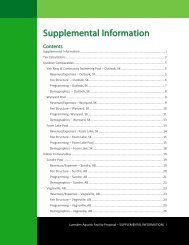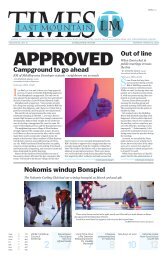LM Times August 12th 2019
You also want an ePaper? Increase the reach of your titles
YUMPU automatically turns print PDFs into web optimized ePapers that Google loves.
4 Last Mountain <strong>Times</strong> • Monday, <strong>August</strong> 12, <strong>2019</strong> • lmtimes.ca<br />
Letter to the<br />
Editor<br />
Responses<br />
were<br />
straightforward<br />
and<br />
believable<br />
Thank you for the article<br />
titled: “NDP Leader and<br />
two candidates in town”, in<br />
the July 22nd edition of the<br />
Last Mountain <strong>Times</strong>. The<br />
discussion concerning the<br />
proposed Yancoal project<br />
was particularly interesting<br />
for me. My assessment of the<br />
Yancoal-related questions<br />
and answers relayed in the<br />
article did not “trash” Yancoal<br />
as your by-line at the top of<br />
the article suggested. Rather,<br />
I felt Ms. Nordal’s responses<br />
to questions about the project<br />
were straightforward and<br />
believable. Having attended<br />
several Yancoal project-related<br />
meetings sponsored by the<br />
Rural Municipality over the<br />
past several years, I believe<br />
that Ms. Nordal’s assessment<br />
of the project status, her view<br />
concerning the Environmental<br />
Assessment process flaws, and<br />
her suggestion to be careful<br />
about generalizing about the<br />
level of support for the project,<br />
is accurate. It is always good<br />
to learn about both the pros<br />
and cons concerning significant<br />
projects that would have<br />
a major impact on our farm<br />
community. The Yancoal proposal<br />
is an example of a project<br />
where lots has been written<br />
about potential economic<br />
benefits to local communities,<br />
but very little information has<br />
been available regarding the<br />
local farming community’s<br />
concerns about a major industrial<br />
development that would<br />
be located in their midst.<br />
-James Hoffman, Strasbourg<br />
(a ratepayer in RM 219<br />
Longlaketon, and not a member<br />
of a Yancoal ‘watchdog’ group)<br />
Disclaimer: opinions expressed<br />
are those of the writer<br />
Myths and misinformation fog<br />
climate change debate<br />
The answers to some questions to help you assess<br />
whether there really is a climate emergency<br />
With energy and the environment<br />
playing an important role in the fall<br />
election, Canadians face starkly different<br />
policy positions from political parties,<br />
together with a bewildering array of both<br />
information and disinformation. Here<br />
is my rather eclectic list of little-known<br />
facts, head-scratching paradoxes and<br />
utter hypocrisy.<br />
Climate Emergency<br />
On June 17, the House of Commons<br />
passed a motion declaring a National<br />
Climate Emergency. Firstly, there is<br />
no such thing as a “national” climate<br />
emergency. Climate change is global, not<br />
national, and Canada’s contribution to<br />
global carbon dioxide (CO2) emissions is<br />
a minuscule 1.6 per cent.<br />
Here are the answers to some questions<br />
that will help you assess whether<br />
there’s really a climate emergency. How<br />
much CO2 is in the atmosphere and how<br />
fast is it growing? A 2018 report from<br />
the U.S. National Oceans and Atmospheric<br />
Administration (NOAA) gives<br />
the answer. The concentration of CO2<br />
in the atmosphere is one molecule per<br />
2,500 molecules, compared with one<br />
molecule per 3,000 molecules 50 years<br />
ago. That’s an average growth rate of<br />
just 10 molecules per year. Apocalyptic<br />
projections of rapid sea level rises<br />
are driving municipal and provincial<br />
governments on both our east and west<br />
coasts to implement sea level rise plans.<br />
These include sterilizing waterfront from<br />
development, building sea barriers and<br />
Reality check<br />
Moe’s Sask. Party trumps Ford’s<br />
Conservatives when it comes to<br />
sketchy political donations<br />
Ontario Premier Doug Ford may be catching heat for promoting<br />
a winery on his propaganda network after accepting<br />
$2,050 in donations from its president, but Saskatchewan is<br />
still the ‘wild west’ when it comes to campaign finance laws.<br />
Thanks to outdated laws that the Sask. Party has refused<br />
to change, Saskatchewan is the only province in Canada that<br />
still allows big money to dominate its elected government and<br />
its decisions. Corporations, unions, organizations and individuals,<br />
including those from out of province, are allowed to<br />
donate unlimited amounts to Saskatchewan political parties<br />
and candidates. And the Sask. Party takes full advantage of the<br />
legislative vacuum, raking in millions from many of the same<br />
people and businesses that in turn enjoy lucrative government<br />
contracts and Crown board appointments.<br />
One need look no further than the backyard of the provincial<br />
even buying out and destroying homes<br />
that are deemed vulnerable. So just how<br />
fast are sea levels rising? Here again,<br />
the NOAA provides the answer. Despite<br />
all the calamitous rhetoric, the NOAA<br />
states that sea levels “continue to rise at<br />
the rate of about one-eighth of an inch<br />
(3.2 mm) per year.” At that rate, a house<br />
built 10 feet above sea level today would<br />
still be 9 feet 7 inches above sea level 40<br />
years from now.<br />
Climate Change Hypocrisy<br />
South Africa, India, the Philippines,<br />
South Korea, Japan and China – all<br />
signatories to the Paris climate accord<br />
– are building a combined 1,800 new<br />
coal-fired power plants. Coal plants emit<br />
twice as much CO2 as natural gas plants.<br />
Meanwhile, international environmental<br />
groups campaign against sending Canadian<br />
LNG to those countries.<br />
And here at home, Justin Trudeau’s<br />
Liberals have introduced a tax specifically<br />
designed discourage the building<br />
of new cleaner-burning gas-fired power<br />
plants as they pursue the fantasy that<br />
wind and solar will keep the lights on.<br />
Good luck with that. After hundreds of<br />
billions of dollars invested, wind and solar<br />
contribute just two per cent of global<br />
energy supply. And that’s only when the<br />
wind is blowing, and the sun is shining.<br />
Climate Change Monovision<br />
The Intergovernmental Panel on<br />
Climate Change (IPCC) would have us<br />
believe that fossil fuel emissions are the<br />
sole reason for climate change. But what<br />
EDITORIALS, LETTERS & OPINIONS<br />
about urbanization and deforestation? A<br />
study by the UN Department of Economic<br />
and Social Affairs states that the urban<br />
population rose from 750 million in 1950<br />
to 4.2 billion in 2018. We don’t need<br />
the IPCC’s complex computer models to<br />
know that cities are hotter. All we have<br />
to do is walk from a paved sun-heated<br />
street lined with concrete buildings to a<br />
grassy park. Rather than reflecting the<br />
sun’s rays back to outer space, all that<br />
concrete and pavement absorbs the sun<br />
rays, creating a giant heat sink. Likewise,<br />
deforestation is turning vast tracts of<br />
cool African and South American jungles<br />
into heat-absorbing barrens. The U.S.<br />
EPA summarizes the combined effect,<br />
“Processes such as deforestation and<br />
urbanization … contribute to changes in<br />
climate.” Trying to deal with any problem<br />
without considering all possible<br />
causes is both a foolish and dangerous<br />
strategy.<br />
First, do no harm<br />
The Liberal government’s proposed<br />
“national clean fuel standard” requires<br />
increased biofuel content in motor fuels.<br />
Government mandated biofuel content<br />
requirements in North America and the<br />
EU have driven the burning of critically<br />
important jungle habitat to make way for<br />
palm oil plantations. On the islands of<br />
Borneo and Sumatra, more than 50,000<br />
Orangutans have died because of palm<br />
oil deforestation.<br />
Who burns the stuff anyway?<br />
Several municipal councils, including<br />
Toronto and Victoria, are looking to sue<br />
fossil-fuel producers for causing climate<br />
change, but 70 per cent of emissions<br />
CONTINUES on PAGE 6<br />
Legislative building for evidence, where the Sask. Party recently<br />
rewrote the rules governing Wascana Park to push through<br />
a shockingly sweet deal on prime public real estate for their<br />
largest corporate donor, that also donated $10,000 to Scott<br />
Moe’s leadership campaign.<br />
A simple comparison of the Sask Party’s donor list to the<br />
Government of Saskatchewan’s annual payee list (Public<br />
Accounts Vol. 2) reveals a pattern repeated year after year: a<br />
steady stream of cash flowing from donors to the Sask Party<br />
amounting to over $2 million over the last decade, and a long<br />
list of government contracts going to Sask. Party donors.<br />
In 2017, the Saskatchewan NDP tabled legislation to ban all<br />
corporate and union donations in order to hand power back to<br />
the people of our province, but the Sask Party government’s<br />
MLAs unanimously voted against the measure.<br />
Alberta, Manitoba, Quebec, Nova Scotia, and British Columbia<br />
have moved to limit influence on their politics, but Scott<br />
Moe’s Sask. Party seems just fine with the status quo. Doug<br />
Ford only wishes he had it so good.<br />
-Ryan Meili, Leader of NDP Opposition<br />
Disclaimer: opinions expressed are those of the writer




